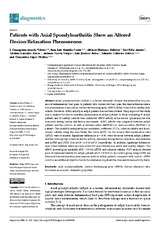Mostrar el registro sencillo del ítem
Patients with Axial Spondyloarthritis Show an Altered Flexion/Relaxation Phenomenon
| dc.contributor.author | Aranda-Valera, I. Concepción | |
| dc.contributor.author | Garrido Castro, Juan Luis | |
| dc.contributor.author | Martínez Galisteo, A. | |
| dc.contributor.author | Peña Amaro, J. | |
| dc.contributor.author | González-Navas, Cristina | |
| dc.contributor.author | Cuesta-Vargas, Antonio | |
| dc.contributor.author | Jiménez Reina, L. | |
| dc.contributor.author | Collantes Estévez, Eduardo | |
| dc.contributor.author | López Medina, Eloísa Clementina | |
| dc.date.accessioned | 2021-04-30T07:18:02Z | |
| dc.date.available | 2021-04-30T07:18:02Z | |
| dc.date.issued | 2021 | |
| dc.identifier.uri | http://hdl.handle.net/10396/21325 | |
| dc.description.abstract | Axial spondyloarthritis (axSpA) is a chronic rheumatic disease characterized by the presence of inflammatory back pain. In patients with chronic low back pain, the lumbar flexion relaxation phenomenon measured by surface electromyography (sEMG) differs from that in healthy individuals. However, sEMG activity in axSpA patients has not been studied. The purpose of this study was to analyze the flexion relaxation phenomenon in axSpA patients. A study evaluating 39 axSpA patients and 35 healthy controls was conducted. sEMG activity at the erector spinae muscles was measured during lumbar full flexion movements. sEMG activity was compared between axSpA patients and the controls, as well as between active (BASDAI ≥ 4) and non-active (BASDAI < 4) patients. The reliability (using intraclass correlation coefficients (ICC)), criterion validity and discriminant validity using the area Under the curve (AUC) for the inverse flexion/relaxation ratio (1/FRR) were evaluated. Significant differences (p < 0.05) were observed between axSpA patients and the control group in lumbar electric activity, especially during flexion, relaxation, and extension and in FRR and 1/FRR (0.66 ± 0.39 vs. 0.25 ± 0.19, respectively). In addition, significant differences were found between active and non-active but also between non-active and healthy subjects. The sEMG showed good reliability (ICC > 0.8 for 1/FRR) and criterion validity. ROC analysis showed good discriminant validity for axSpA patients (AUC = 0.835) vs. the control group using 1/FRR. An abnormal flexion/relaxation phenomenon exists in axSpA patients compared with controls. sEMG could be an additional objective tool in the evaluation of patient function and disease activity status. | es_ES |
| dc.format.mimetype | application/pdf | es_ES |
| dc.language.iso | eng | es_ES |
| dc.publisher | MDPI | es_ES |
| dc.rights | https://creativecommons.org/licenses/by/4.0/ | es_ES |
| dc.source | Diagnostics 11(5), 810 (2021) | es_ES |
| dc.subject | Axial spondyloarthritis | es_ES |
| dc.subject | Surface electromyography (sEMG) | es_ES |
| dc.subject | Flexion relaxation ratio | es_ES |
| dc.subject | Functional assessment | es_ES |
| dc.subject | Clinimetric properties | es_ES |
| dc.title | Patients with Axial Spondyloarthritis Show an Altered Flexion/Relaxation Phenomenon | es_ES |
| dc.type | info:eu-repo/semantics/article | es_ES |
| dc.relation.publisherversion | http://dx.doi.org/10.3390/diagnostics11050810 | es_ES |
| dc.relation.projectID | Junta de Andalucía. PIN-0079-2016 | es_ES |
| dc.rights.accessRights | info:eu-repo/semantics/openAccess | es_ES |

